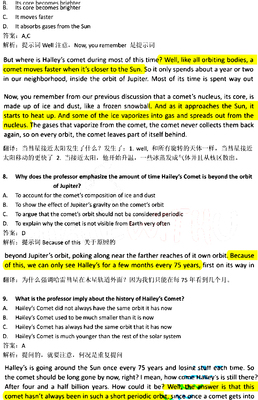Groundwater

Most of the world’s potablewater-freshwater suitable for drinking-is accounted for bygroundwater, which is stored in the pores and fractures in rocks.There is more than 50 times as much freshwater stored undergroundthan in all the freshwater rivers and lakes at the surface. Nearly50 percent of all groundwater is stored in the upper 1,000 metersof Earth. At greater depths within Earth, the pressure of theoverlying rock causes pores and cracks to close, reducing the spacethat pore water can occupy, and almost complete closure occurs at adepth of about 10 kilometers. The greatest water storage,therefore, lies near the surface.
世界上大部分可饮用的淡水都是储存在岩石孔洞和缝隙中的地下水。在地下的淡水有所有储存在地表淡水湖泊和河流的淡水的50倍以上。接近50%的地下水都出藏在地球表面1,000米的地层中。在地球深层,过多的岩石使得孔洞和裂缝关闭,减少水可以占据的孔隙,并且在10kM左右的深度孔洞是几乎完全关闭的。因此,最多的储存水是在贴近地表的地方
Aquifers地下蓄水层,Porosity有孔性,and Permeability 渗透性
Groundwater is stored in a variety of rocktypes. A groundwater reservoir from which water can be extracted iscalled an aquifer. We can effectively think of an aquifer as adeposit of water. Extraction of water depends on two properties ofthe aquifer: porosity and permeability. Between sediment grains arespaces that can be filled with water. This pore space is known asporosity and is expressed as a percentage of the total rock volume.Porosity is important for water-storage capacity, but for water toflow through rocks, the pore spaces must be connected. The abilityof water, or other fluids, to flow through the interconnected porespaces in rocks is termed permeability. Fractures and joint havevery high permeability. In the intergranular spaces of rocks,however, fluid must flow around and between grains in a tortuouspath; this winding path causes a resistance to flow. The rate atwhich the flowing water overcomes this resistance is related to thepermeability of rock.
地下水储存在许多不同种类的岩石中。一个可以取出地下水的地下水储存所被叫做地下蓄水层。我们可以认为地下蓄水层是水的堆积物。汲水取决于地下蓄水层的两个性质:有孔性和渗透性。在沉积颗粒间是储水的空间。这些孔洞空间被叫做有孔性并且用岩石总体积的百分比来表示。有孔性对岩石的蓄水容量很重要,但为使水可以从岩石中流过,孔洞必须是连接在一起的。水或其他液体在岩石孔洞中流淌的能力叫做渗透性。然而,在岩石内部的小空隙中和孔隙之间水或其他液体必须在迂回曲折的路线中流淌,这蜿蜒的道路会造成逆流。水流抵挡这种逆流的速率与岩石的渗透性有关。
Sediment sorting and compaction influencepermeability and porosity. The more poorly sorted or the moretightly compacted a sediment is, the lower its porosity andpermeability. Sedimentary rocks-the most common rock type near thesurface are also the most common reservoirs for water because theycontain the most space that can be filled with water. Sandstonesgenerally make good aquifers, while finer-grained mudstones aretypically impermeable. Impermeable rocks are referred to asaquicludes. Igneous and metamorphic rocks are more compact,commonly crystalline, and rarely contain spaces between grains.However, even igneous and metamorphic rocks may act as groundwaterreservoirs if extensive fracturing occurs in such rocks and if thefracture system is interconnected.
沉积层的种类和压缩程度影响了渗透性和多孔性。一个沉积物分类越贫瘠或压缩越紧密,它的渗透性和多孔性就越低。沉积岩,地表最常见的岩石种类也是最常见的蓄水处,因为它们含有可以储存水的空间最多。沙石大致组成了良好的地下蓄水层,少孔的泥岩则是典型的不可渗透。岩浆岩和变质岩则更紧密,大多是结晶体并且很少有孔隙。然而即使是岩浆岩和变质岩也会在岩石中出现大量断裂时或断裂系统内部链接起来时会成为地下水储藏处。
The WaterTable
The water table is the undergroundboundary below which all the cracks and pores are filled withwater. In some cases, the water table reaches Earth’s surface,where it is expressed as rivers, lakes, andmarshes. Typically, though, the water table maybe tens or hundreds of meters below the surface. The water table isnot flat but usually follows the contours of the topography. Abovethe water table is the vadose zone, through which rainwaterpercolates. Water in the vadose zone drains down to the watertable, leaving behind a thin coating of water on mineral grains.The vadose zone supplies plant roots near the surface withwater.
地下水位
水位是所有蓄水的空洞和缝隙的地下分界。在某些情况下,地下水位达到了地表,形成河流,湖泊和沼泽。然而,典型的地下水位一般在地下几十或几百米处。地下水位线不是平滑的但也遵循地形学的等高线。地下水位以上是渗流带,雨水从中渗入。渗流带的水渗入地下水位下,在矿物质层上留下一层薄的水层。渗流带为贴近地表的植物种子提供水份。地下水位
水位是所有蓄水的空洞和缝隙的地下分界。在某些情况下,地下水位达到了地表,形成河流,湖泊和沼泽。然而,典型的地下水位一般在地下几十或几百米处。地下水位线不是平滑的但也遵循地形学的等高线。地下水位以上是渗流带,雨水从中渗入。渗流带的水渗入地下水位下,在矿物质层上留下一层薄的水层。渗流带为贴近地表的植物种子提供水份。
Because the surface of the water table isnot flat but instead rises and falls with topography, groundwateris affected by gravity in the same fashion as surface water.Groundwater flows downhill to topographic lows. If the water tableintersects the land surface, groundwater will flow out onto thesurface at springs, either to be collected there or to subsequentlyflow farther along a drainage. Groundwater commonly collects instream drainages but may remain entirely beneath the surface of drystreambeds in arid regions. In particularly wet years, shortstretches of an otherwise dry streambed may have flowing waterbecause the water table rises to intersect the landsurface.
应为水位线的表面不平坦而且随地形上下起伏,地下水像地表水一样受重力影响。地下水向地势低处流动。如果水位线与地面相交叉,地下水就会在春季涌出地面,从那里被收集或顺着排水渠留到远处。地下水通常通过蒸发排水收集,但在干燥地区则全部留在干燥河床以下。在特别多雨的年份,因为地下水位线上升到与地平线有交集,特别干燥的排水渠的短支流也会有水。
 爱华网
爱华网


